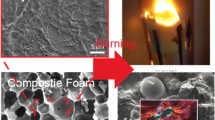Abstract
Formaldehyde scavenger agent can effectively control formaldehyde emissions from wood-based panels, but the existing formaldehyde scavenger agent can only work in the short term. For the purpose of long-term control of formaldehyde emissions from wood-based panels, microencapsulation of formaldehyde scavenger agent was synthesized in this paper. The effect of the emulsifying agent and the core to shell ratio on the microcapsules' morphology and formaldehyde degradation efficiency was investigated. The results showed that microcapsules of optimum morphology with high degradation efficiency can be obtained under the condition of 1% of the sodium dodecyl sulfate emulsifier, 3% of the shell solution, and a core to shell ratio of 1:3 with 1000 r/min stirring speed. The loading ratio and efficiency of the microcapsules achieved 36.25% and 8.05% respectively. Compared with control panels, the formaldehyde released from veneered panels treated with microcapsules was 39.7% and 41.4% lower in short-term and long-term emissions.







Similar content being viewed by others
References
Alani AWG, Fatease AMA, Stammet M, Cote B, Rao DA (2016) Evaluation of the stability of resveratrol Pluronic® micelles prepared by solvent casting and simple equilibrium methods. Pharm Nanotechnol 4:120–125
Alves L, Lindman B, Klotz B, Bottcher A, Haake HM, Antunes FE (2018) On the rheology of mixed systems of hydrophobically modified polyacrylate microgels and surfactants: role of the surfactant architecture. J Colloid Interface Sci 513:489–496
Boran S, Usta M, Gümüskaya E (2011) Decreasing formaldehyde emission from medium density fiberboard panels produced by adding different amine compounds to urea formaldehyde resin. Int J Adhes Adhes 31:674–678
Duan H (2015) The study on environment-friendly urea-formaldehyde resin adhesives and the control on formaldehyde emissions. Dissertation, Beijing University of Chemical Technology
Dunky M (1998) Urea–formaldehyde (UF) adhesive resins for wood. Int J Adhes Adhes 18:95–107
Ebrahimi M, Kazemi Najafi S, Behrooz R (2017) Effect of relative humidity and temperature on formaldehyde emission from MDF subjected to load. Int Wood Prod J 8:1–6
Furuno T, Imamura Y, Kajita H (2004) The modification of wood by treatment with low molecular weight phenol-formaldehyde resin: a properties enhancement with neutralized phenolic-resin and resin penetration into wood cell walls. Wood Sci Technol 37:349–361
Gao SL, Zhang XZ (2005) Studies on compatibility and thermal stability of EC/CA blends. Chin J Appl Chem 8:923–925
Huang S, Wei W, Weschler LB, Salthammer T, Kan H, Bu Z, Zhang Y (2017) Indoor formaldehyde concentrations in urban China: preliminary study of some important influencing factors. Sci Total Environ 590–591:394–405
Jagels R (2010) Health hazards of natural and introduced chemical components of boatbuilding woods. Am J Ind Med 8:241–251
Kotani T, Ichimoto I, Tatsumi C, Fujita T (2008) Structure-activity study of bacteriostatic kojic acid analogs. J Agric Chem Soc Jpn 39:1311–1317
Lebowitz MD, Quackenboss JJ (1993) Formaldehyde: exposure effects on human health. In: Morton C (ed) Handbook of hazardous materials. Academic Press, San Diego, pp 285–291
Li SF, Ye GL (2012) Photocatalytic degradation of formaldehyde by TiO2 nanoparticles immobilized in activated carbon fibers. Adv Mater Res 482:2539–2542
Ni S, Liu C, Hua J (2018) Aldehyde-lowering method and equipment design of artificial panel ammonia treatment. Mod Sci Instrum 1:93–96
Parthasarathy S, Maddalena RL, Russell ML, Apte MG (2011) Effect of temperature and humidity on formaldehyde emissions in temporary housing units. J Air Waste Manag Assoc 61:689–695
Petry T, Cazelle E, Lloyd P, Mascarenhas R, Stijntjes G (2013) A standard method for measuring benzene and formaldehyde emissions from candles in emission test chambers for human health risk assessment purposes. Environm Sci Process Impacts 15:1369–1382
Shi F, Sun C (2019) Manufacture and application of formaldehyde scavenger in E0 grade particleboard. China Wood Based Panels 17:18–21
Yan X, Cai Y, Guo W, Yang R, Qian X, Pan P, Xu W (2019a) Preparation of urea-formaldehyde@epoxy resin microcapsule and its effect on waterborne wood coatings. J For Eng 4:160–164
Yan X, Qian X, Wu Z (2019b) Self-repairing technology of microencapsulate and its applications in coatings. J For Eng 4:20–28
Yang S, Wang Y, Li G, Fan D (2018) Performances of lignin phenol formaldehyde resin modified by urea. J For Eng 3:38–43
Zhu X, Bao B, Li Y, Wang W, Liu Y (2020) Effect of thermochromic materials on finishing properties of wood furniture. J For Eng 5:171–178
Zorpas AA, Skouroupatis A (2016) Indoor air quality evaluation of two museums in a subtropical climate conditions. Sustain Cities Soc 20:52–60
Funding
This research was funded by Fundamental Research Funds for the Central Universities, Grant no [2572018BB06], Heilongjiang natural science foundation, Grant no [C2017002], Ministry of Advanced Education and Skills Development (CA)National undergraduate training programs for Innovation and entrepreneurship, Grant no [201810225001].
Author information
Authors and Affiliations
Corresponding author
Ethics declarations
Conflict of interest
No potential conflict of interest was reported by the authors.
Additional information
Publisher’s note
Springer Nature remains neutral with regard to jurisdictional claims in published maps and institutional affiliations.
Rights and permissions
About this article
Cite this article
Liu, Y., Qin, X., Zhu, X. et al. Microencapsulation of formaldehyde scavenger agent and its application to veneered panels. Eur. J. Wood Prod. 79, 579–588 (2021). https://doi.org/10.1007/s00107-021-01656-8
Received:
Accepted:
Published:
Issue Date:
DOI: https://doi.org/10.1007/s00107-021-01656-8




